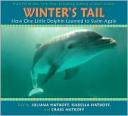Winter's Tail: How One Dolphin Learned to Swim Again, told by Juliana Hatkoff, Isabella Hatkoff, and Craig Hatkoff, is a heartwarming book that chronicles the amazing true story of Winter, a three-month old Atlantic bottle-nosed dolphin who lost her tail after becoming entangled in a crab trap. The book contains the actual photographs as Winter was rescued from Mosquito Lagoon (near Cape Canaveral) by Hubbs-SeaWorld Research Institute. She was then transported to the Clearwater Marine Aquarium, a rescue, rehab, and release stranding center for marine animals.
Winter's journey at Clearwater Marine Aquarium was not an easy one at first. But Winter persevered and eventually was able to swim on her own. The problem was her tail was so injured that it fell off. Without her tail, she swished her tail stump from side to side like a fish, instead of the up-and-down tail action of a dolphin. "Winter had taught herself an entirely new way to swim!" But her trainers were concerned this would damage her backbone. As Winter adapted to her new home & not having a tail, it became even more apparent that she needed to learn how to swim like a dolphin to avoid further injury and develop muscles properly.
Luckily Kevin Carroll, a premier creator of prostheses, heard about Winter's dilemma and believe he could help. Working with a team of experts, and despite many obstacles, they were eventually able to create a new, innovative prosthetic tail for Winter. This new tail helps to keep her backbone healthy and her body flexible. It also resulted in these innovations crossing over to bring more advanced technology to prosthetics for humans.
The book goes on to say that Winter and her visitors seem to have a special connection…
From children who have prostheses, to veterans who lost a limb fighting in a war, to one little girl who didn't want to wear a hearing aid until she met Winter, people saw how Winter learned to adapt and are inspired by her story.
Beyond all expectations, Winter has thrived and has become an inspiration to the disabled and able-bodied alike. Winter's inspiring story uses narrative writing and fantastic photographs to deliver an important message of hope, adaptation, friendship, and universal acceptance.
Curriculum Connections
Winter's Tail: How One Little Dolphin Learned to Swim Again can be used to introduce and/or enhance many of the life science Standards of Learning. Winter's ability to adapt to her new environment at the aquarium and to her prothetic tail can show the key concept of behavioral and structural adaptions when investigating how animals in an ecosystem interact with one another and the nonliving environment. (VA SOL 4.5a) Looking at how the crab trap placed in the water by humans caused the dolphin to become entangled and injured can be an example of possible negative influences of human activities on ecosystems. (VA SOL 4.5f) Concepts of Winter's instinct and learned behavior can be explored. (VA SOL 3.4b) The student can investigate the physical characteristics (body coverings, body shape, appendages, and methods of movement) of the Atlantic Bottlenose dolphin and explore the importance of the dolphin's tail as an appendage that allows a dolphin to survive in the wild. (VA SOL 1.5b).
Additional Resources
- Students can have the opportunity to watch the real "Winter" using live webcams at Clearwater Marine Aquarium. It allows the viewer to observe Winter from several different views. This is a wonderful way to allow children to connect the story to the actual dolphin.
- Turtle Pond Collection has a site dedicated to Winter including dolphin facts, a singalong, games, pictures, and more.
- Sea World has a really cool site filled with educational opportunities including Animal Infobooks for many animals including bottle-nosed dolphins, Teacher Guides, Classroom Activities (including a Habitat Sweet Habitat Lesson Plan), Games and more.
General Information
Book: Winter's Tail: How One Little Dolphin Learned to Swim Again
Author: Jauliana Hatkoff, Isabella Hatkoff & Craig Hatkoff
Illustrator: n/a
Publisher: Scholastic Press
Publication Date: 2009
Pages: 40
Grade Range: PreK – 6
ISBN-10: 0545123356
ISBN-13: 978-0545123358

